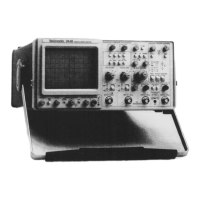Operator's Checks and Adjustments—2445 Operators
3. Connect the Channel 1 probe (using the probe hook
tip) to the oscilloscope CALIBRATOR output.
4. Set triggering controls for a stable display. The dis
play should be five cycles of the CALIBRATOR square-
wave signal, with an amplitude of four divisions. Center the
display on the screen.
5. Check the waveform for overshoot and rolloff (see
Figure 5-1). If necessary, use a small-bladed screwdriver to
adjust the probe low-frequency compensation for a square
front corner on the waveform.
6. Release the CH 1 VERTICAL MODE switch, select
CH 2 VERTICAL MODE, and connect the Channel 2 probe
input to the CALIBRATOR output. Observe that the
CH 2 SCALE FACTOR on the readout display indicates
100 mV with the 10X probe attached.
7. Use the Channel 2 POSITION control to vertically
center the display and repeat step 5 for the Channel 2
probe.
NOTE
Refer to the instruction manual supplied with the
probe for more complete information about low-
frequency and high-frequency compensation o f
the probes.
MATCHING CHANNEL 2 DELAY
The apparent signal delay in Channel 2 may be adjusted
up to ±500 ps to match the apparent delay present in any
of the other three channels. This adjustment is most com
monly used to eliminate delay differences between Chan
nel 1 and Channel 2 that may be introduced by the probes
and has no effect on common-mode rejection when ADD
VERTICAL MODE is selected. Matching Channel 1 and
Channel 2 delay is accomplished as follows:
1. Preset the instrument controls and obtain a baseline
trace as described in "Initial Setup."
2. Connect the two 10X probes (supplied with the
instrument) to the CH 1 OR X and CH 2 input connectors.
3. Check and adjust, if necessary, the probes' low-
frequency compensation. Refer to "Probe Low-Frequency
Compensation" in this section.
4. Connect both probes via hook tips to a pulse gener
ator fast-rise output.
5. Press in both the CH 1 and CH 2 VERTICAL MODE
switches.
6. Set oscilloscope triggering controls for a stable
display.
Figure 5-1. Probe low-frequency compensation.
7. Set the A AND B SEC/DIV switches to 10 ns.
8. Adjust the Channel 1 and Channel 2 POSITION
controls to vertically overlay the two displayed signals.
9. Pull out the B SEC/DIV switch and observe the
message CH 2 DELAY — TURN A in the upper right-hand
corner of the screen.
NOTE
The 2445 can be set to preclude operator adjustment
of Channel 2 delay. If the delay-offset feature is
disabled, the message CH 2 DLY DISABLED appears
in the top row of the readout when attempting to
activate the feature. Refer the instrument to a
qualified service technician if adjustment of the
delay matching is required.
5-3

